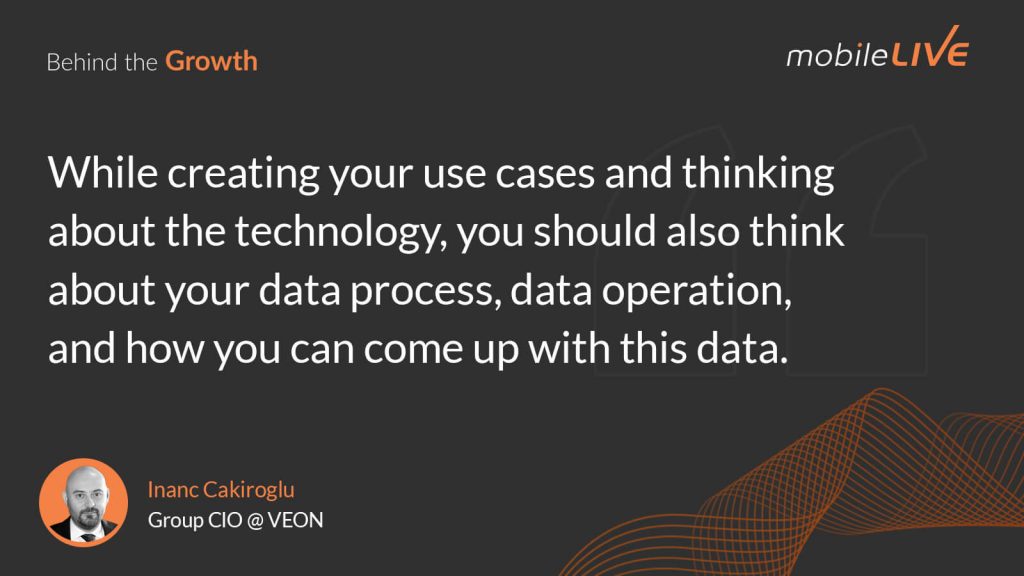
Jump To Section
Most businesses today acknowledge the transformative power of AI but get bogged down in the complexities of implementation.
Recently on Behind the Growth, I had the pleasure of interviewing Inanc Cakiroglu, Group CIO at VEON, to celebrate his impressive journey in the field. Inanc has over 25 years of experience in ICT and has witnessed firsthand the evolution of AI from a niche technology to a powerful force shaping industries worldwide.
In this blog post, we’ll distill Inanc’s insights into three fundamental steps to unlock the full potential of AI.
Define Before You Design: Start with the Business Problem
Inanc stresses the need for a clear and well-defined problem statement as the foundation for any successful AI project–”The first principle thinking.”
In his words, “It is basically getting a business problem, business case, dividing it into very smaller pieces into various smaller, grander components, and then starting with the very basic approach, solving these basic pieces and creating complex solutions.”
He observed that companies are getting caught up in the excitement of AI and jumping into solutions without first identifying the core problem they’re trying to solve.
“Usually, everybody thinks about which application area they should apply AI, which kind of AI technologies they should adopt, which kind of AI solutions or the data or analytic solutions they should be looking at,” Inanc notes. “But I think the technology shouldn’t be the starting point. The starting point should be a use case.”
Think of it like building a house. Just like you wouldn’t start constructing walls without a blueprint, similarly, diving headfirst into AI solutions without a clear understanding of your core business problem is a recipe for wasted resources and underwhelming results.
Instead, take the time to break down complex challenges into smaller, actionable components. For example, instead of broadly stating “We need to improve customer experience,” define a specific problem like “Reduce customer churn by 15%” or “Increase online sales conversions by 10%.”
This laser focus, driven by a clearly defined use case, will guide you towards the most relevant and impactful AI solutions.
Explore the Approach: Solving the Business Problem
Once you’ve defined your business problem, the next step is to explore the possible ways to solve the business problem. Inanc emphasizes that technology should not be the starting point but rather a means to an end.
To guide this process, he outlines the possible filter actions with examples:
1. Classification
Refers to sorting data into defined categories. For example, an AI-powered chatbot can classify customer queries by intent or priority and direct them to the relevant department or agent.
2. Prediction
Uses historical data to forecast future trends or outcomes. For instance, businesses can apply predictive AI to foresee customer churn, detect fraud, or optimize inventory management.
3. Matching
Identifies similarities or connections between data points. AI-powered recommendation engines, for example, use this to suggest products or services based on a customer’s past purchases or browsing behaviour.
4. Insight Generation
It involves extracting valuable insights from complex data. Businesses can use AI to analyze customer sentiment, identify market trends, or gain deeper operational insights.
By understanding which “filter action” aligns with your desired outcome, you can narrow down the vast array of AI solutions and choose the one that best fits your needs.
The Fuel For Success: The Crucial Role of Data

Inanc is unequivocal about the importance of data in AI: “Without good established pipelines, you cannot achieve something.” Just as a car can’t run without fuel, AI algorithms can’t deliver meaningful insights or drive effective actions without the right data.
There are three crucial aspects to data readiness that businesses need to address:
1. Data Quality
The accuracy, completeness, and consistency of your data directly impact the performance of your AI models. Garbage in, garbage out, as they say. Therefore, it’s essential to assess the quality of your existing data and identify any gaps or inconsistencies that need to be addressed.
2. Data Pipelines
Having established pipelines ensures that data flows seamlessly from various sources to your AI systems. This involves processes for data collection, cleaning, transformation, and integration. Robust data pipelines are essential for delivering timely and reliable insights.
3. Business Process Transformation
In some cases, existing business processes might not generate the data needed for your AI initiatives. In such instances, consider a business process transformation to modify your workflows and systems to capture the relevant data.
Inanc cautions against viewing data preparation as a one-time task: “So in the meantime, while you are creating your use cases and thinking about technology, you should also think about your data process, your data operation, how you can come up with this data.”
Effective AI implementation requires a continuous focus on data quality, pipeline management, and adapting business processes as needed.
Takeaway
To unlock AI’s full potential, follow these three key steps:
- Define your business problem with precision.
- Choose the right AI solution for the challenge.
- Ensure your data is ready to power the process.
By adopting this approach, you can move beyond the hype and leverage AI to drive meaningful results.
If you found these insights valuable, be sure to tune into the full episode of Behind the Growth for a conversation with Inanc Cakiroglu you don’t want to miss! You’ll gain even deeper insights into the evolving AI landscape, the potential of emerging technologies, and practical advice for leveraging AI to transform your business.
Link to podcast:
Simple & Clear Business Problems for Effective AI
You can also tune in on your favourite channel:



